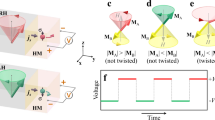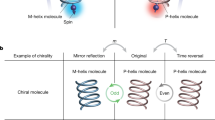Abstract
An object is considered chiral if its mirror image cannot be brought to coincide with itself by any sequence of simple rotations and translations1. Chirality on a microscopic scale—in molecules2,3, clusters4, crystals5 and metamaterials6,7—can be detected by differences in the optical response of a substance to right- and left-handed circularly polarized light2,3. Such ‘optical activity’ is generally considered to be a consequence of the specific distribution of electronic charge within chiral materials. Here, we demonstrate that a similar response can also arise as a result of spin excitations in a magnetic material. Besides this spin-mediated optical activity (SOA), we observe notable differences in the response of Ba2CoGe2O7—a square-lattice antiferromagnet that undergoes a magnetic-field driven transition to a chiral form—to terahertz radiation travelling parallel or antiparallel to an applied magnetic field. At certain frequencies the strength of this magneto-chiral effect8,9,10 is almost complete, with the difference between parallel and antiparallel absorption of the material approaching 100%. We attribute these phenomena to the magnetoelectric 11,12 nature of spin excitations as they interact with the electric and magnetic components of light.
This is a preview of subscription content, access via your institution
Access options
Subscribe to this journal
Receive 12 print issues and online access
$259.00 per year
only $21.58 per issue
Buy this article
- Purchase on SpringerLink
- Instant access to full article PDF
Prices may be subject to local taxes which are calculated during checkout




Similar content being viewed by others
References
Kelvin, L. Baltimore Lectures on the Molecular Dynamics and the Wave Theory of Light (C.J. Clay & Sons, 1904).
Barron, L. D. Molecular Light Scattering and Optical Activity (Cambridge Univ. Press, 2004).
Berova, N., Nakanishi, K. & Woody, R. W. Circular Dichroism: Principles and Applications 2nd edn (Wiley-VCH, 2000).
Micali, N. et al. Selection of supramolecular chirality by application of rotational and magnetic forces. Nature Chem. 4, 201–207 (2012).
Hsu, E. C. & Holzwarth, G. Vibrational circular dichroism observed in crystalline α-NiSO·6HO and α-ZnSeO·6HO between 1900 and 5000 cm−1. J. Chem. Phys. 59, 4678–4685 (1973).
Kuwata-Gonokami, M. et al. Giant optical activity in quasi-two-dimensional planar nanostructures. Phys. Rev. Lett. 95, 227401 (2005).
Hendry, E. et al. Ultrasensitive detection and characterization of biomolecules using superchiral fields. Nature Nanotech. 5, 783–787 (2010).
Baranova, N. B. & Zeldovich, B. Ya. Theory of a new linear magnetorefractive effect in liquids. Mol. Phys. 38, 1085–1098 (1979).
Barron, L. D. & Vrbancich, J. Magneto-chiral birefringence and dichroism. Mol. Phys. 51, 715–730 (1984).
Rikken, G. L. J. A. & Raupach, E. Observation of magneto-chiral dichroism. Nature 390, 493–494 (1997).
Fiebig, M. Revival of the magnetoelectric effect. J. Phys. D 38, R123–R152 (2005).
Spaldin, N. A. & Fiebig, M. The renaissance of magnetoelectric multiferroics. Science 309, 391–392 (2005).
Greenfield, N. J. Using circular dichroism spectra to estimate protein secondary structure. Nature Protocols 1, 2876–2890 (2007).
Stephens, P. J., Devlin, F. J. & Pan, J-J. The determination of the absolute configurations of chiral molecules using vibrational circular dichroism (VCD) spectroscopy. Chirality 20, 643–663 (2008).
Alagna, L. et al. X-ray natural circular dichroism. Phys. Rev. Lett. 80, 4799–4802 (1998).
Train, C. et al. Strong magneto-chiral dichroism in enantiopure chiral ferromagnets. Nature Mater. 7, 729–734 (2008).
Rikken, G. L. J. A. & Raupach, E. Pure and cascaded magnetochiral anisotropy in optical absorption. Phys. Rev. E 58, 5081–5084 (1998).
Koerdt, C., Duchs, G. & Rikken, G. L. J. A. Magnetochiral anisotropy in Bragg scattering. Phys. Rev. Lett. 91, 073902 (2003).
Saito, M., Ishikawa, K., Taniguchi, K. & Arima, T. Magnetic control of crystal chirality and the existence of a large magneto-optical dichroism effect in CuB2O4 . Phys. Rev. Lett. 101, 117402 (2008).
Van Aken, B. B., Rivera, J-P., Schmid, H. & Fiebig, M. Observation of ferrotoroidic domains. Nature 449, 702–705 (2007).
Pimenov, A. et al. Possible evidence for electromagnons in multiferroic manganites. Nature Phys. 2, 97–100 (2006).
Kida, N. et al. Terahertz time-domain spectroscopy of electromagnons in multiferroic perovskite manganites. J. Opt. Soc. Am. B 26, A35–A51 (2009).
Sushkov, A. B., Aguilar, R. V., Park, S., Cheong, S-W. & Drew, H. D. Electromagnons in multiferroic YMn2O5 and TbMn2O5 . Phys. Rev. Lett. 98, 027202 (2007).
Rovillain, P. et al. Electric-field control of spin waves at room temperature in multiferroic BiFeO3 . Nature Mater. 9, 975–979 (2010).
Kézsmárki, I. et al. Enhanced directional dichroism of terahertz light in resonance with magnetic excitations of the multiferroic Ba2CoGe2O7 oxide compound. Phys. Rev. Lett. 106, 057403 (2011).
Zheludev, A. et al. Spin waves and the origin of commensurate magnetism in Ba2CoGe2O7 . Phys. Rev. B 68, 024428 (2003).
Murakawa, H., Onose, Y., Miyahara, S., Furukawa, N. & Tokura, Y. Ferroelectricity induced by spin-dependent metal-ligand hybridization in Ba2CoGe2O7 . Phys. Rev. Lett. 103, 137202 (2010).
Perez-Mato, J. M. & Riberio, J. L. On the symmetry and the signature of atomic mechanisms in multiferroics: the example of Ba2CoGe2O7 . Acta Crystallogr. A 67, 264–268 (2011).
Miyahara, S. & Furukawa, N. Theory of magnetoelectric resonance in two-dimensional S = 3/2 antiferromagnet Ba2CoGe2O7 via spin-dependent metal-ligand hybridization mechanism. J. Phys. Soc. Jpn 80, 073708 (2011).
Tonouchi, M. Cutting-edge terahertz technology. Nature Photon. 1, 97–105 (2007).
Nuss, M. C. & Orenstein, J. in Millimeter and Submillimeter Wave Spectroscopy of Solids (ed. Grüner, G.) (Springer, 1998).
Acknowledgements
We thank T. Arima and K. Penc for discussions. This work was supported by KAKENHI, MEXT of Japan, by Funding Program for World-Leading Innovation R&D on Science and Technology (FIRST program) on ‘Quantum Science on Strong Correlation’, by Hungarian Research Funds OTKA PD75615, Bolyai 00256/08/11, TA’MOP-4.2.2.B-10/1–2010-0009 and by the Estonian Ministry of Education and Research under Grant SF0690029s09, and Estonian Science Foundation under Grants ETF8170 and ETF8703.
Author information
Authors and Affiliations
Contributions
S.B., I.K., T.R., U.N., D.S. and L.D. performed the measurements and analysed the data; H.M. and Y.O. contributed to the sample preparation; N.K., R.S., T.R. and U.N. developed the experimental set-up; S.M. and N.F. developed the theory; S.B. and I.K. wrote the manuscript; and Y.T. and I.K. planned the project.
Corresponding author
Ethics declarations
Competing interests
The authors declare no competing financial interests.
Supplementary information
Supplementary Information
Supplementary Information (PDF 589 kb)
Rights and permissions
About this article
Cite this article
Bordács, S., Kézsmárki, I., Szaller, D. et al. Chirality of matter shows up via spin excitations. Nature Phys 8, 734–738 (2012). https://doi.org/10.1038/nphys2387
Received:
Accepted:
Published:
Issue date:
DOI: https://doi.org/10.1038/nphys2387
This article is cited by
-
Nonreciprocal directional dichroism at telecom wavelengths
npj Quantum Materials (2022)
-
Nonvolatile chirality switching in terahertz chalcogenide metasurfaces
Microsystems & Nanoengineering (2022)
-
Confirming the trilinear form of the optical magnetoelectric effect in the polar honeycomb antiferromagnet Co2Mo3O8
npj Quantum Materials (2022)
-
Electric Dipole Active Magnetic Resonance and Nonreciprocal Directional Dichroism in Magnetoelectric Multiferroic Materials in Terahertz and Millimeter Wave Regions
Applied Magnetic Resonance (2021)
-
Time-domain terahertz spectroscopy in high magnetic fields
Frontiers of Optoelectronics (2021)



